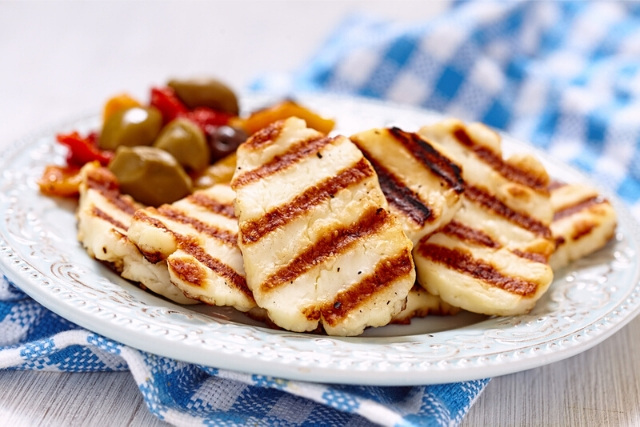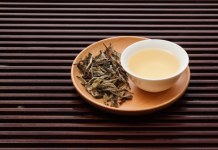Halloumi is a semi-hard cheese typically made from the milk of goats, sheep or cows and traditionally from the Middle East. It’s a semi-hard, unripened, brined cheese that has quite a salty flavor.
In this article:
What are the Benefits of Halloumi?
Nutrition Value of Halloumi
How can I Consume Halloumi?
Side Effects of Eating Halloumi
Can it be Eaten During Pregnancy?
Can we give Halloumi to Kids?
Simple Recipes with Halloumi
All You Need to Know About Before Including Halloumi in Your Diet
What are the Benefits of Halloumi?
Halloumi is high in protein making it a good vegetarian alternative (in moderation, of course). From a nutritional perspective, Halloumi is also an excellent source of calcium, providing 70% of the adult recommended daily allowance in one portion. Halloumi also contains zinc, selenium, magnesium, vitamin A and many B vitamins.
Nutrition Value of Halloumi
A single 1-ounce (28-gram) serving of halloumi contains the following nutrients:
- Calories: 110
- Carbs: 0 grams
- Protein: 7 grams
- Fat: 9 grams
- Calcium: 25% of Daily Value (DV)
- Sodium: 15% of the DV
How can I Consume Halloumi?
Because it has a higher melting point than many other types of cheese, it can be grilled or fried without becoming runny and losing its shape. For this reason, it’s typically served cooked, which enhances the cheese’s signature salty taste and makes it slightly crispy on the outside.
Side Effects of Eating Halloumi
Some people may be more sensitive to the effects of salt, so a high intake could cause issues like water retention and bloat. Just keep an eye on the number of calories in halloumi, especially if you’re trying to lose weight.
Additionally, while raw halloumi contains a moderate number of calories, it’s often consumed fried or coated in oil. This can significantly increase the calorie content of the final product, likely contributing to weight gain. It’s also rich in saturated fat, a type of fat that may contribute to increased levels of LDL (bad) cholesterol when consumed in huge amounts.
Also, note that halloumi is not suitable for those following a dairy-free or vegan diet.
Can it be Eaten During Pregnancy?
A healthy portion size of halloumi is about 80 grams, roughly palm-sized, but it isn’t advisable to consume halloumi every day due to its high saturated fat and salt content.
Can we give Halloumi to Kids?
Avoid chunky hard cheeses, since they could be a choking hazard for a baby who’s not able to chew well yet. But small portions of halloumi cut up in small, soft chunks is fine enough. But remember, children cannot eat more than 100gs of sodium a day and halloumi is rich in sodium.
Simple Recipes with Halloumi
Fried Halloumi Cheese Mezze
Ingredients
- 1 (8-ounce) package halloumi cheese (drained and cut into 3/8-inch slices)
- Olive oil (for brushing)
- For the Garnish
- Freshly ground black pepper (to taste)
- Oregano or mint leaves
- 4 to 5 cherry tomatoes (cut in half)
- Balsamic vinaigrette
Directions
- Preheat a nonstick frying pan over high heat.
- Dry the halloumi cheese slices by blotting them with a paper towel. Place the slices on a plate and brush both sides lightly with the olive oil to coat each thoroughly.
- Sear the cheese in the hot pan until each slice develops a deep brown crust, about 1 minute on the first side and 1 to 2 minutes on the other.
- Place the fried cheese on a plate and garnish with the pepper, herbs, tomatoes, and vinaigrette.
Halloumi, Harissa and Honey Toastie
Ingredients
- olive oil for frying
- Halloumi 250g, cut into 6 slices
- butter 40g
- sourdough 4 slices, lightly toasted
- rose harissa 2 tsp
- honey 2 tbsp
- tomatoes 2, sliced
Directions
- Heat a frying pan over medium heat with a drizzle of olive oil and fry the halloumi for a couple of minutes on each side until golden then remove. Wipe the pan clean.
- Divide the halloumi between 2 slices of the bread, smear the rose harissa onto the halloumi, drizzle with honey and lay the tomato slices on top. Season well with black pepper, then put the other slices of toasted bread on top and press down.
- Heat half the butter in the same frying pan. Add the sandwiches then weigh down with a plate and a tin of beans. Once golden, flip, add the remaining butter and repeat on the other side until golden and toasted.
Halloumi Shawarma
Ingredients
- shawarma paste or spice blend 1 tbsp, (we used Belazu)
- lemon ½, juiced
- halloumi 1 block, cut into thin slices
- cucumber ½, diced
- tomatoes 2, diced
- red onion ½, finely chopped
- olive oil 1 tbsp
- red wine vinegar for taste
- hummus 150g
- natural yogurt 150g
- mint a handful of leaves
- flatbreads 3 large, warmed
Directions
- Heat the grill to high. Mix together the shawarma paste and lemon juice, and brush all over the halloumi. Spread out on a baking tray and leave for 5 minutes.
- Meanwhile, toss the cucumber, tomatoes and red onion with the oil and red wine vinegar, and season. Mix together the hummus and yogurt.
- Grill the halloumi, turning once, until golden and sizzling.
- Divide the hummus yogurt between 3 plates and swirl. Top with the hot halloumi, sprinkle over the salad and the mint. Serve with warm flatbreads for scooping.
Sources
https://www.bbcgoodfood.com/howto/guide/halloumi-healthy
https://www.healthline.com/nutrition/what-is-halloumi#benefits
https://www.thenational.ae/lifestyle/wellbeing/the-worst-foods-you-can-feed-your-kids-1.301922













